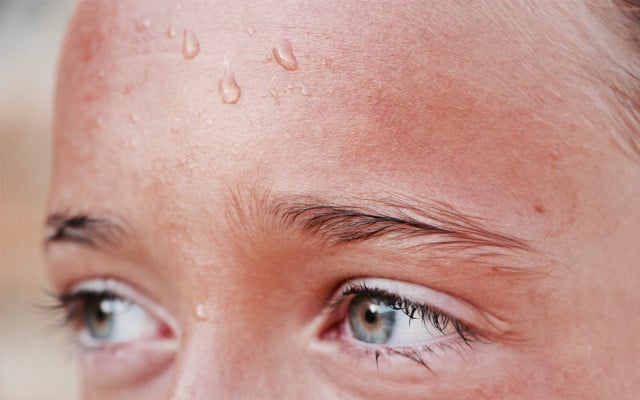
It’s hot again in almost all of Germany, the weather service warns – and gradually there is an awareness that this is no reason to be happy: The increasing heat is affecting human health and causing fatalities worldwide. But how hot is actually too hot for the human body?
People have different perceptions of temperature: some can really enjoy 30 degrees in the shade, others hardly dare to go outside. At some point, almost every human body will react to heat with dangerous stress symptoms. The answer to the question of how much heat humans can actually tolerate is becoming more and more explosive in view of the rising temperatures – and difficult for science to answer.
“Heat waves are linked to the climate crisis”
Weather and climate researchers around the world are now pretty sure: extreme heat is becoming more frequent, longer and hotter. “Heat waves are fundamentally to be associated with the climate crisis,” says the meteorologist and ZDF weather presenter Özden Terli. “You really don’t have to hold back with this statement today.”
However, the increasing heat does not only cause droughts, forest fires and water shortages: Experts believe that hundreds of thousands of heat deaths worldwide are already due to the effects of the climate crisis. According to a study from 2021, the death rate during heat waves increases particularly sharply in Germany.

The elderly and people with health restrictions are among the people who are particularly at risk in the heat. Heat is also particularly dangerous for babies, small children, pregnant women and many chronically ill people. But when does it get too hot even for average, healthy adults?
“You can’t really draw a clear line,” says weather expert Terli. Temperatures above 35 degrees are often considered particularly critical in public perception. “But even lower temperatures and high humidity can be stressful for the body.”
When does heat become dangerous?
It’s not just the heat that’s dangerous: research shows that, in addition to temperature, humidity is also a key factor in how the body reacts to heat. From this, it is hardly possible to calculate a simple threshold à la “from X degrees it is dangerous”.
In connection with the effects of heat and humidity, the term wet-bulb temperature (also: cooling limit temperature) appears again and again. What is meant by this is “the lowest temperature that can still be achieved by direct evaporative cooling”, as the science magazine Spektrum explains. In other words, a certain combination of heat and humidity above which the human body temperature begins to rise because the body can no longer emit heat through sweating (=evaporation). This overheating of the body can be life-threatening.
However, wet-bulb temperature was not originally developed for application to the human body and is overly simplistic. Nevertheless, previously assumed values are alarming: Only recently, an experiment indicated that the critical threshold could be lower than previously assumed: According to a study by scientists at Pennsylvania State University, an average wet-bulb temperature of around 31 degrees Celsius – reaches 36 to 40 degrees outside temperature.

Even if the concept is not ideal for describing the effects of heat on humans because it does not take all factors into account, the US researchers formulate an important finding: “A threshold value […] cannot be applied to human adaptability for all climatic conditions.”
In other words, heat can always be dangerous. It would not make sense to rely on a specific value below which we can feel safe. Rather, we should always be as careful as possible at high temperatures – and especially when the air is humid – and protect ourselves and others.
ZDF weather expert Terli predicts rather dry heat for the coming August days in Germany. Nevertheless, he warns:
“You have to be really careful if that’s possible. You have to take it easy when it gets too hot, and especially when it’s still damp.”
Why overheating is life threatening
Because: If the so-called “critical environmental limit” is exceeded – i.e. the combination of humidity and ambient temperature above which the body can no longer cool itself – then the core temperature of the body rises. The heat accumulates in the body when it can no longer dissipate it through sweating.

The heart then works faster and harder to pump blood through the skin so the body can dissipate heat. Sweating also reduces body fluids. Overheating (heatstroke or sunstroke) can quickly become life-threatening.
Read more: Heat emergency: How to react correctly
The “felt temperature”
The meteorologist Prof. Dr. Andreas Matzarakis from the Center for Medical Meteorological Research at the German Weather Service (DWD). He considers a combination of psychological surveys and standardized measurements of the most important body parameters to be more sensible. Such calculations – combined with values for temperature, humidity and wind conditions – form the basis for the “perceived temperature” used by the DWD and the published heat warnings.
There are also critical threshold values for the “perceived temperature”, but these are variable. “People perceive the temperatures at the beginning of the hot season differently than at the end, there is a certain adjustment that takes place,” says Matzarakis. At the beginning of summer, the threshold above which heat-related deaths increase is around 32 degrees, towards the end of summer it rises to over 34 degrees.

However, the humidity can increase the “perceived temperature” even at lower temperatures. Because: The higher the humidity, the slower the evaporation of sweat on the skin and thus the body’s own cooling. In particular, when the air temperature rises above the average skin temperature of around 33 degrees, it becomes more difficult for the body to cool itself. “People cope with dry heat waves more easily than humid heat waves,” says the meteorologist.
“Temperatures above 35 degrees do not belong in Germany”
Both Terli and Matzerakis predict that as climate change progresses, not only will the number of hot days increase in Germany, but also the number of warm and humid days, i.e. days with high temperatures and high humidity. This increases the risk of heat-related health hazards.
Because: Many experts warn that humans cannot adapt to higher temperatures and humidity levels at the pace at which climate change is driving them. Matzarakis also says:
“Humans can only adapt to heat to a limited extent and only partially.”
Özden Terli also points out: “Temperatures well above 30 degrees or even above 35 degrees do not really belong in Germany. They are inherently dangerous – even when the air is dry.”
The extreme scenarios for rising moisture levels are not yet foreseeable. And: There are still many uncertainties about the effects of the climate crisis beyond heat and humidity. “We have to be prepared for the fact that we will experience completely different effects.”
Read more: How the climate crisis threatens our health
Tips for dealing with heat
It’s easy for people who primarily work at a desk, of course, to talk, but: When temperatures are high, we should all protect ourselves as much as possible, for example by drinking a lot, avoiding direct sunlight, and reducing physical activity.
Here are tips for dealing with the heat:
- What to do when it’s hot The best tips for surviving the heat wave
- 5 tips against heat: This is how southern Europeans do it
- Cooling your home without air conditioning: tips & tricks
- Sleeping in the heat: 12 common mistakes that make you sleep less well
- Preventing sunburn: 10 tips you should know
- Animals suffer from the heat: Here’s how you can help
Read more on Techzle.com:
- Climate protection: 15 simple tips that anyone can do
- SUV fans and frequent flyers: This is how you talk to people who don’t care about the climate crisis
- Hirschhausen: Heat is the “greatest health hazard” of this century